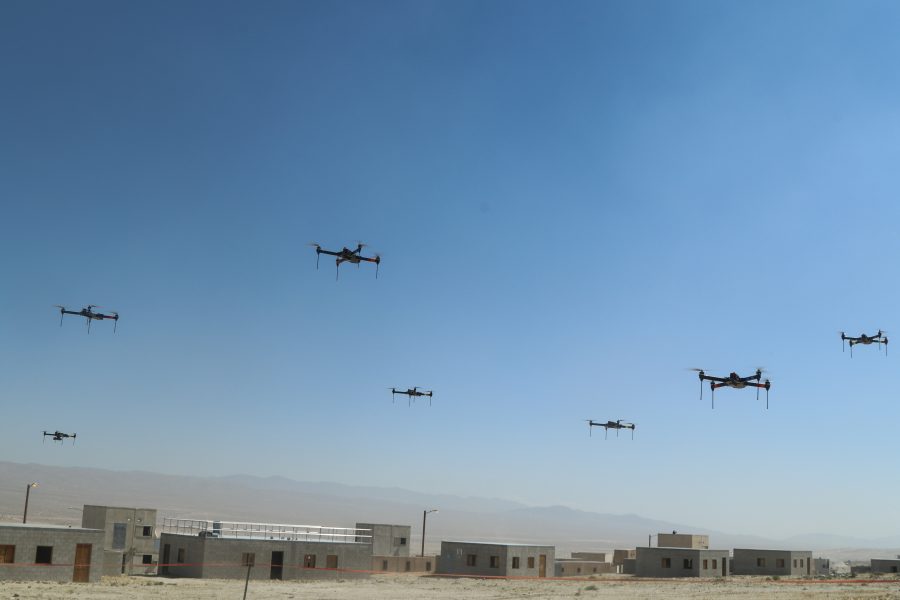The Pentagon’s Defense Innovation Unit is soliciting industry to offer commercial, inexpensive, one-way drones to perform a variety of battlefield tasks—and the military wants them soon.
The DIU said that once a solution or solutions are chosen, there may be no further competition and that selected systems may go right into development “following a live flight demonstration during Phase 2 of the Commercial Solutions Opening (CSO) selection process,” according to an agency announcement. The Pentagon’s technology arm wants responses by midnight on Oct. 14.
Under the expedited format, the government is looking for heavy involvement of small businesses or “nontraditional” defense contractors.
The solicitation did not specify that the uncrewed aerial systems would be used by any particular military service. It also did not refer to the Pentagon’s year-old Replicator initiative, in which inexpensive, autonomous systems would be produced at scale to augment and enhance the fighting force.
“Recent conflicts”—presumably in Ukraine and the Middle East—“have highlighted the asymmetric impact low-cost, one-way unmanned aerial systems (UAS) have on the modern battlefield,” the DIU said. The Defense Department “must be able to employ low-cost precision effects at extended ranges. Reliable, affordable, and adaptable UAS platforms that allow for employment at scale will maximize operational flexibility for the joint force,” it added.
The Pentagon wants commercial systems that:
- Can operate from 50-300+ kilometers with at least a 10 Kg payload; “ideally, 25+ Kg”
- “Launch quickly and expeditiously” from the ground
- Are “difficult to detect and track”
- Navigate at low altitudes
- Carry a variety of payloads
- Operate beyond-line-of-sight in “disrupted, disconnected, intermittent and low-bandwidth (DDIL) and Global Navigation Satellite System (GNSS)-denied environments.”
The DIU wants systems “capable of supporting high-speed, low-altitude, beyond-line-of-sight flight operations” under DDIL conditions, explaining that the UAS “should be able to execute its mission without continuous communication from an operator, though solutions that provide multiple pathways and mechanisms for two-way communications are desired.”
The announcement didn’t specify cost bounds for the submitted systems.
Replies are to be in the form of a short presentation that describes “the mechanism of ground launch, operational limitations, and rate of launch per team.” The DIU said it strongly recommends all proposals “be formatted as presentations no more than 12 slides in length.”
Responses are to explain “the ability of the platform to perform terminal guidance in denied environments and the capabilities available on the platform to support such maneuvers.”
Companies pitching a system have to provide details on “the precision, accuracy, and reliability of the proposed solution,” the number of flight tests accomplished so far, and “any information about testing environments, production facilities, and projected production capacities.”
Companies proposing a solution also have to “discuss the mission planning software that will be made available with the submitted platform.” That software should be “intuitive and integrate other first- and third-party platforms.”
The DIU noted that offerings will be assessed for their ability to “on the order of hours, integrate third-party software and hardware components (including payloads) in a modular, warm-swappable manner.”
Offerings must also use open hardware and software interfaces “that allow for seamless integration of third-party systems.”
The DIU isn’t interested in an intellectual property negotiation. It won’t accept any “proprietary interfaces, message formatting or hardware” requiring vendor licensing.
While DIU will accept “teaming solutions,” all proposals must “address the hardware and software requirements holistically.”
Any award made in response to the solicitation “may result in the award of a follow-on production contract or transaction without the use of further competitive procedures,” DIU said. The resulting “follow-on production contract or transaction will be available for use by one or more organizations in the Department of Defense and, as a result, the magnitude of the follow-on production contract or agreement could be significantly larger than that of the prototype” agreement.
Any prototype “Other Transaction” deal may result “in the award of a follow-on production contract or transaction without the use of competitive procedures,” DIU said.


